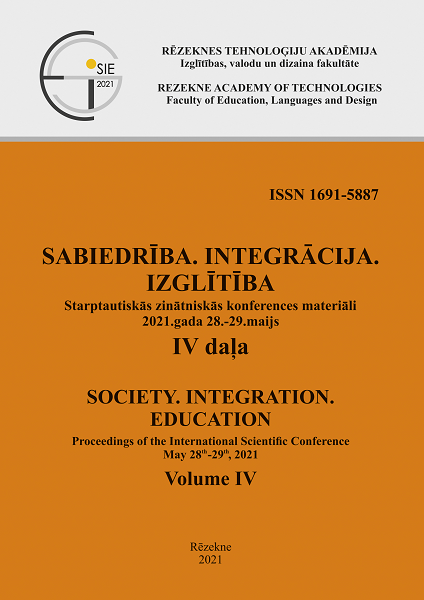INFLUENCE OF INCLUSIVE AND SEGREGATIVE PHYSICAL EDUCATION FOR SCHOOLCHILDREN OF DIFFERENT MEDICAL GROUPS
DOI:
https://doi.org/10.17770/sie2021vol4.6169Keywords:
inclusion, mental state, physical education, schoolchildrenAbstract
The study aimed to compare the effectiveness of inclusive and segregative physical education classes for students of various medical groups, taking into account sociopsychological indicators and indicators of psychoemotional state. The study involved 1,414 schoolchildren aged 10–16 years (M=12.7, SD=1.6). Through the survey, pupils’ wellbeing, needs, motivations, and motor preferences at their leisure and physical education classes, level of situational and personal anxiety, degree of integration of the group, and motivation for success were ascertained. Data comparisons were made between schoolchildren who studied in segregated and inclusive ways of organizing physical education in schools. Attitudes towards schoolchildren’s physical education and leisure patterns make it possible to assert that an inclusive model is effective. Integrative physical education classes are less mentally traumatic, more convenient, and psychologically comfortable than segregative ones. The way physical education is organized does not affect the level of anxiety and the class’s degree of motivation in achieving success in schoolchildren’s activities. Positive changes in the integrative conditions in the mental state come with all schoolchildren, but they are most noticeable among schoolchildren with low functional reserve capabilities.
References
Ahverdova, O. A., Gjulushanjan, K. S., & Kolenkina, V. V. (2006). Praktikum po social'noj psihologii. Moskva, TC Sfera.
Bertills, K., Granlund, M., & Augustine, L. (2019). Inclusive Teaching Skills and Student Engagement in Physical Education. Frontiers in Education, 4, 74. https://doi.org/10.3389/feduc.2019.00074
Biddle, S. J. H., & Asare, M. (2011). Physical activity and mental health in children and adolescents: A review of reviews. British Journal of Sports Medicine, 45(11), 886-895. https://doi.org/10.1136/bjsports-2011-090185
Bodnar, І. (2013). Dynamics of dextery, speed, explosive force, and flexibility indices in schoolchildren belonging to different medical groups. Fizichna aktivnist', zdorov’ia i sport, 4(14), 13-22.
Bodnar, I., & Prystupa, E. (2014). Efficiency of inclusive physical education lessons for schoolchildren with minor deviations in health. Postępy reabilitacji, 3, 13-19.
Edmunds, S., Biggs, H., & Goldie, I. (2013). Let’s get physical: The impact of physical activity on wellbeing. Mental Health Foundation, 38, 1-47.
Fibbins, H., Ward, P. B., Watkins, A., Curtis, J., & Rosenbaum, S. (2018). Improving the health of mental health staff through exercise interventions: a systematic review. Journal of Mental Health, 27(2), 184-191. https://doi.org/10.1080/09638237.2018.1437614
Haycock, D., & Smith, A. (2010). Inclusive physical education? A study of the management of national curriculum physical education and unplanned outcomes in England. British Journal of Sociology of Education, 31(3), 291-305. https://doi.org/10.1080/01425691003700532
Hodge, S., Ammahb, J. O. A., Casebolt, K. M., LaMaster, K., Hersman, B., Samalot-Rivera, A., & Sato, T. (2009). A diversity of voices: Physical education teachers’ beliefs about inclusion and teaching students with disabilities. International Journal of Disability, Development and Education, 56(4), 401-419. https://doi.org/10.1080/10349120903306756
Kokun, O. M., Pishko, I. O., Lozins`ka, N. S., Kopany`cya, O. V., & Malxazov, O. R. (2011). Zbirny`k metody`k dlya diagnosty`ky` psy`xologichnoyi gotovnosti vijs`kovosluzhbovciv vijs`kovoyi sluzhby` za kontraktom do diyal`nosti u skladi my`rotvorchy`x pidrozdiliv. Kyiv.
Lleixà, T., & Nieva, C. (2020). The social inclusion of immigrant girls in and through physical education. Perceptions and decisions of physical education teachers. Sport, Education and Society, 25(2), 185-198. https://doi.org/10.1080/13573322.2018.1563882
Qi, J., & Ha, A. S. (2012). Inclusion in Physical Education: A review of literature. International Journal of Disability, Development and Education, 59(3), 257-281. https://doi.org/10.1080/1034912X.2012.697737
Pavlova, I. (2015). Life quality and health of children and youth of Ukraine. Slobozhanskyi Herald of Science and Sport, 46(2), 148–153. https://doi.org/10.15391/snsv.2015-2.029
Pavlova, I., Vynogradskyi, B., Ripak, I., Zikrach, D., & Borek, Z. (2016). Prognostication of health-related life quality of Ukrainian residents due to physical activity level. Journal of Physical Education and Sport, 16(2), 418-423. https://doi.org/10.7752/jpes.2016.02065
Reiner, M., Niermann, C., Jekauc, D., & Woll, A. (2013). Long-term health benefits of physical activity-a systematic review of longitudinal studies. BMC Public Health, 13, 813. https://doi.org/10.1186/1471-2458-13-813
Rekaa, H., Hanisch, H., & Ytterhus, B. (2019). Inclusion in Physical Education: Teacher Attitudes and Student Experiences. A Systematic Review. International Journal of Disability, Development and Education, 66(1), 36-55. https://doi.org/10.1080/1034912X.2018.1435852
Rogowska, A. M., Pavlova, I., Kuśnierz, C., Ochnik, D., Bodnar, I., & Petrytsa, P. (2020). Does Physical Activity Matter for the Mental Health of University Students during the COVID-19 Pandemic? Journal of Clinical Medicine, 9(11), 3494. https://doi.org/10.3390/jcm9113494
Rozanova, V. A. (1999). Psihologija upravlenija. Moskva, ZAO “Biznes-shkola “Intel-Sintez”.
Smith, A. (2004). The inclusion of pupils with special educational needs in secondary school physical education. Physical Education & Sport Pedagogy, 9(1), 37-54. https://doi.org/10.1080/1740898042000208115
Spielberger, C. D., Gorsuch, R. L., Lushene, R., Vagg, P. R., & Jacobs, G. A. (1983). Manual for the State-Trait Anxiety Inventory. Palo Alto, CA: Consulting Psychologists Press.
Uher, I., & Bukova, A. (2018). Interrelationship between Exercise and Diseases in young people: Review study. Physical Activity Review, 6, 203-212. https://doi.org/10.16926/par.2018.06.25
Wang, L. (2019). Perspectives of students with special needs on inclusion in general physical education: A social-relational model of disability. Adapted Physical Activity Quarterly, 36(2), 242-263. https://doi.org/10.1123/apaq.2018-0068
Wilhelmsen, T., & Sørensen, M. (2017). Inclusion of children with disabilities in physical education: A systematic review of literature from 2009 to 2015. Adapted Physical Activity Quarterly, 34(3), 311-337. https://doi.org/10.1123/apaq.2016-0017






